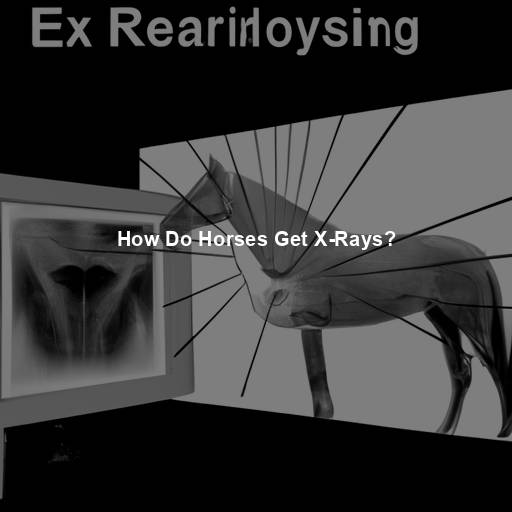How Do Horses Get X-Rays?
Last Updated on November 17, 2023 by Evan
When it comes to our equine friends, it’s no secret that their majestic presence has captivated humans for centuries. However, like any living creature, horses are not immune to the occasional injury or health complication. In these instances, veterinarians often turn to the venerable X-ray machine for answers. But have you ever stopped to wonder how, exactly, horses go about getting X-rays?
Contents
Understanding X-Rays
X-rays are a form of electromagnetic radiation that can pass through the body and create images of internal structures. These images can help veterinarians identify fractures, bone abnormalities, or other health issues that may not be visible from the outside. X-rays are widely used in both human and veterinary medicine and have revolutionized the way we diagnose and treat various conditions.
Equine Radiography
Equine radiography, or horse X-rays, is a specialized field within veterinary medicine. It involves capturing images of a horse’s bones and other internal structures using X-ray equipment. The process is similar to human X-rays, but there are some unique considerations when dealing with horses.
Preparing the Horse
Preparing a horse for an X-ray is a crucial endeavor, demanding utmost attention to detail and a touch of serenity. Calming the majestic equine through sedation is of paramount importance, guaranteeing a harmonious atmosphere during the procedure. It’s a formidable task, as horses possess an imposing physique, making it all the more perplexing to position them flawlessly for the X-ray imaging sans sedation. Thus, ensuring not only the horse’s safety but also that of the veterinary team becomes an enchanting tightrope walk.
X-Ray Equipment for Horses
When it comes to harnessing the power of X-rays for our equine friends, the tools used bear a remarkable resemblance to those employed on humans. Yet, in order to cater to the grand stature and intricate anatomy of horses, certain adaptations have been made. It is within these very distinctions that the captivating world of equine radiography unfolds, leaving us marveling at the intricate dance between technology and the majestic beings we call horses. Step into the realm of equine radiography and unlock the enigmatic secrets that lie beneath the surface.
Portable X-Ray Machines
When it comes to capturing X-rays for our four-legged equine friends, the action is taking place right where the magic happens – out in the field! Instead of confining the majestic horses to the sterile environment of a veterinary clinic, the clever use of portable X-ray machines brings the clinic to them. These compact wonders, carefully designed to be as lightweight as a feather and as nimble as a ballet dancer, allow skilled veterinarians to weave their way through the rustic charm of barns and the cozy embrace of stables, capturing captivating images right where the hooves meet the ground. A captivating blend of technological prowess and the untamed spirit of these magnificent creatures!
X-Ray Plates and Cassettes
To capture the X-ray images, special plates or cassettes are used. These plates are placed under or against the area of interest on the horse’s body. When the X-ray machine emits radiation, it passes through the horse’s body and strikes the plate, creating a digital image.
Digital Radiography vs. Traditional Film X-Rays
In recent years, digital radiography has become the preferred method for obtaining X-rays in both human and veterinary medicine. Digital X-rays offer several advantages over traditional film X-rays. They provide instant results, eliminate the need for chemical processing, and offer better image quality. Digital X-rays can be easily stored, shared, and edited electronically, making them more convenient and efficient for veterinarians.
The X-Ray Process for Horses
As we venture further into the realm of equine radiography, we cannot help but marvel at the intricacies of the equipment employed in this captivating field. However, our curiosity beckons us to explore beyond the surface and unravel the mystique surrounding the actual process of capturing X-rays for our majestic equine friends. Join us as we embark on a journey filled with anticipation and bewilderment, where every step holds the promise of unveiling a new dimension of knowledge and insight. Prepare to be fascinated, as we delve into the enigmatic world of equine radiography and explore the artistry involved in capturing the invisible wonders that lie within.
Positioning the Horse
Ensuring precise X-ray images, capturing the true essence of equine anatomy, demands a delicate dance of positioning prowess. With meticulous care, veterinarians navigate the realm of sedation, taming the restless spirit of horses, immortalizing their majestic frames on film. Focusing on the desired area, be it a limber leg or a harmonious joint, requires an astute understanding of equine anatomy, a symphony of expertise orchestrated by seasoned professionals. Only then can the captivating image reveal itself, a captivating tapestry of complexity and grace.
Protective Measures
Ensuring the well-being of our equine friends has always been a top priority, and when it comes to veterinary radiography, safety is paramount. In order to shield both our noble steeds and the skilled team caring for them, the use of lead aprons and shields have become a common practice. These protective measures, reminiscent of their human radiography counterparts, serve as a bulwark against radiation exposure, thereby minimizing any potential risks and ensuring the overall safety of all parties involved. So rest assured, when it comes to radiographic examinations for horses, we leave no stone unturned to keep both our four-legged companions and their dedicated caretakers out of harm’s way.
Taking the X-Ray Images
When it comes to capturing images of horses for diagnostic purposes, a well-thought-out process is crucial. After ensuring that the horse is correctly positioned and safety measures are in full effect, it’s time to unleash the X-ray machine. With precision and care, the machine is carefully positioned at a calculated distance from the majestic creature, ready to emit its mysterious radiation. As the X-rays travel through the intricate details of the horse’s anatomy, they meet the digital plate or cassette with a purpose, illuminating and creating a mesmerizing visual representation of what lies beneath.
Reviewing and Interpreting the Images
Once the X-ray images have been captured, they undergo a significant transformation in the hands of a skilled veterinarian. With the magic of technology, these images are brought to life on a computer screen, allowing for a meticulous examination that leaves no abnormality unnoticed. The veterinarian’s watchful eye scans every pixel, searching for signs of injury or any perplexing irregularities that might be lurking beneath the surface. To ensure precision, they may even delve into the treasure trove of previous X-ray images or call upon the wisdom of fellow specialists, embarking on a collaborative quest for a definitive diagnosis.
Benefits and Limitations of Equine X-Rays
Equine X-rays offer several benefits in diagnosing and treating horse-related health issues. They provide valuable insights into the horse’s internal structures, allowing for accurate diagnoses and treatment plans. X-rays can help detect fractures, arthritis, bone tumors, and other conditions that may require intervention. However, it is important to note that X-rays have limitations as well.
Limitations of Equine X-Rays
Equine X-rays, despite their usefulness, are not without their limitations. One such constraint is the inability to capture the full scope of a horse’s internal structure, making it challenging to diagnose certain conditions accurately. Additionally, the positioning required for X-rays can be quite difficult for large and unruly horses, leading to potential complications during the imaging process. Furthermore, X-rays alone may not provide a comprehensive understanding of complex equine injuries or abnormalities, necessitating the use of additional diagnostic techniques for a more complete assessment.
- Soft Tissue Visibility: X-rays primarily visualize bones and dense structures. Soft tissues, such as tendons and ligaments, may not be clearly visible on X-ray images.
When it comes to capturing the inner workings of a horse’s body, X-rays have their limitations. These powerful imaging tools excel at focusing on specific areas, but their narrow field of view leaves much of the horse’s body shrouded in mystery. Unfortunately, this means that potential problems lurking in other areas may go unnoticed when relying solely on X-rays. So, while X-rays offer valuable insights, they shouldn’t be the sole diagnostic tool, lest we miss hidden ailments waiting to perplex us in the shadows.
Radiation Exposure: Ah, the enigmatic world of X-rays. These powerful yet perplexing beams of energy have long fascinated both scientists and skeptics alike. Now, while we’re no strangers to taking precautions to shield ourselves from this invisible force, let’s not brush off the fact that even X-rays come with their own little dose of radiation. Fear not, for the amount emitted during these intriguing procedures is typically quite low, deemed safe by the experts.
Sedation and Safety
Sedation plays a crucial role in ensuring the safety of both the horse and the veterinary team during an X-ray procedure. Horses are large and powerful animals, and it can be challenging to position them correctly without sedation. Additionally, sedation helps keep the horse calm and still, minimizing the risk of injury during the process.
Collaboration with Veterinary Specialists
When it comes to the intricate world of equine medicine, veterinarians often find themselves teaming up with a select group of specialists, including radiologists and orthopedic surgeons. With their extensive knowledge, these skilled experts bring a fresh perspective to the table, shedding light on even the most perplexing cases. By fostering collaboration among the veterinary community, a higher level of understanding is achieved, leading to more precise and comprehensive diagnoses that leave no room for uncertainty.
Follow-up X-Rays
When it comes to ensuring the recovery of our precious equine companions, undergoing follow-up X-rays can shed light on their healing journey. Harnessing the power of technology, veterinarians opt for periodic X-rays to evaluate the trajectory of bone mending, especially in the case of fractures. These post-treatment scans play a pivotal role in guiding veterinarians towards potential adjustments in the treatment plan, working in tandem with their expertise to ensure the best possible outcome for our majestic horses.
Alternative Imaging Techniques
In the world of equine medicine, X-rays have long been the go-to imaging method. However, there’s a secret world of alternative techniques waiting to be discovered. Picture this: ultrasound, MRI, and CT scans taking center stage, each offering their own unique perspectives and challenges. No two modalities are the same, and selecting the right approach depends on the intricacies of the case at hand.
The Importance of Equine X-Rays
Equine X-rays play a crucial role in the diagnosis and treatment of various conditions in horses. They provide valuable information that helps veterinarians make informed decisions regarding the health and well-being of these magnificent animals. Here are some key reasons why equine X-rays are important:
Accurate Diagnoses
X-rays provide detailed images of a horse’s bones and can help identify fractures, bone abnormalities, or degenerative conditions such as arthritis. Accurate diagnoses are the foundation for developing appropriate treatment plans and ensuring the best possible outcome for the horse.
Informed Treatment Decisions
Equine X-rays allow veterinarians to visualize the internal structures of a horse’s body, enabling them to make informed decisions regarding treatment options. For example, if a horse has a fracture, the X-ray images help determine whether surgical intervention is necessary or if conservative management will suffice.
Monitoring Progress and Healing
When it comes to our equine companions, keeping a close eye on their progress and ensuring proper healing is of utmost importance. Enter follow-up X-rays, a crucial tool in the hands of veterinarians to unravel the mysteries of a horse’s journey towards recovery. Through the lens of these diagnostic images, experts can unlock a world of information, unraveling the enigmatic web of bone healing, spotting potential complications, and fine-tuning treatment plans with the precision of a maestro. Always there to lend a helping hand, follow-up X-rays are the unsung heroes that bring clarity to the perplexing path of equine healing.
Pre-Purchase Examinations
X-rays are often part of pre-purchase examinations for horses. Prospective buyers rely on these examinations to assess the horse’s overall health and soundness. X-rays provide valuable insights into the horse’s skeletal system, helping buyers make informed decisions about the horse’s suitability for their intended purpose.
Research and Advancements in Equine Medicine
Equine X-rays contribute to ongoing research and advancements in the field of equine medicine. Imaging techniques, such as digital radiography, continue to evolve, providing veterinarians with better tools to diagnose and treat various conditions. The knowledge gained from equine X-rays helps improve the overall understanding of equine health and contributes to the well-being of horses worldwide.
FAQs – How do horses get x-rays
How are x-rays performed on horses?
X-rays on horses are typically performed by equine veterinarians who specialize in diagnostic imaging. To capture the x-ray image, the horse is usually sedated to ensure it remains still during the procedure. The specific area of interest, such as a leg or a joint, is then carefully positioned and immobilized. The x-ray machine is positioned on the opposite side of the area being imaged, and a special x-ray film or a digital imaging sensor is placed on the other side to capture the image. The x-ray machine emits radiation which passes through the horse’s body and creates an image of the area, allowing veterinarians to evaluate bones, joints, and internal structures.
Are horses sedated for x-rays?
Horses, magnificent creatures that they are, can sometimes become quite restless during an x-ray procedure. That’s where sedation comes into play – a measure taken to ease their nerves and ensure a smooth experience for all involved. By administering sedatives, we help these majestic beings find their tranquil state, allowing us to capture clear and precise images with minimal risk of harm. The amount and type of sedative used will depend on several factors, such as the horse’s disposition, anxiety levels, and the specific area being examined. Trust that our skilled veterinarians will carefully determine the most suitable sedation protocol for each unique case, providing the utmost care and consideration in the process.
Are x-rays dangerous for horses?
When it comes to X-rays, concerns about ionizing radiation’s potential dangers naturally arise. However, in equine X-rays, experts prioritize the safety of both the horse and the involved personnel by closely monitoring and controlling radiation exposure levels. Thanks to modern equipment and skilled professionals, the advantages of diagnostic imaging overshadow the risks associated with radiation. Moreover, additional precautions, like safeguarding sensitive areas with lead aprons and shields, go the extra mile in minimizing unnecessary radiation exposure for the horse, particularly its reproductive organs.
How long does the x-ray process take?
When it comes to x-raying horses, there is no set time frame that can be applied across the board. It’s a time-consuming process that demands a fair share of patience both from the veterinarian and the equine patient. The success of the procedure hinges on various factors, such as the region of interest and the horse’s level of cooperation. From the initial positioning to capturing the necessary images and evaluating their quality, every step plays a vital role in obtaining accurate results. Additional views or repeat images might be necessary, adding to the already complex nature of the process. As a result, the duration can range anywhere from a mere few minutes to an extensive half an hour, or even longer. Thus, the intricacies involved make the entire ordeal a perplexing yet essential aspect of equine healthcare.
Can all horse clinics perform equine x-rays?
When it comes to the intricate realm of equine care, not all horse clinics are created equal. Delving into the fascinating nuances of equine x-rays, one must tread carefully. These majestic creatures demand a specialized touch, requiring x-ray machines of grand proportions and unbridled power. Engaging the services of veterinarians well-versed in the art of diagnostic imaging, or clinics that proudly boast dedicated equine radiography services, is a prudent choice for aspiring horse owners. Take heed, for embarking upon this journey unprepared risks a tumultuous voyage filled with vexing delays and unforeseen perplexities.
Will my horse feel any pain during the x-ray procedure?
When it comes to the x-ray experience for our equine friends, pain is not the main player. It’s more about the careful maneuvering and immobilization that can throw a horseshoe in the works. But fear not, sedation steps in like a trusty sidekick, swooping in to keep any discomfort or stress at bay. Our dedicated veterinarians and technicians make it their mission to prioritize the safety and comfort of these majestic creatures throughout the entire x-ray escapade. Rest assured, your four-legged companion will be in good hands!







